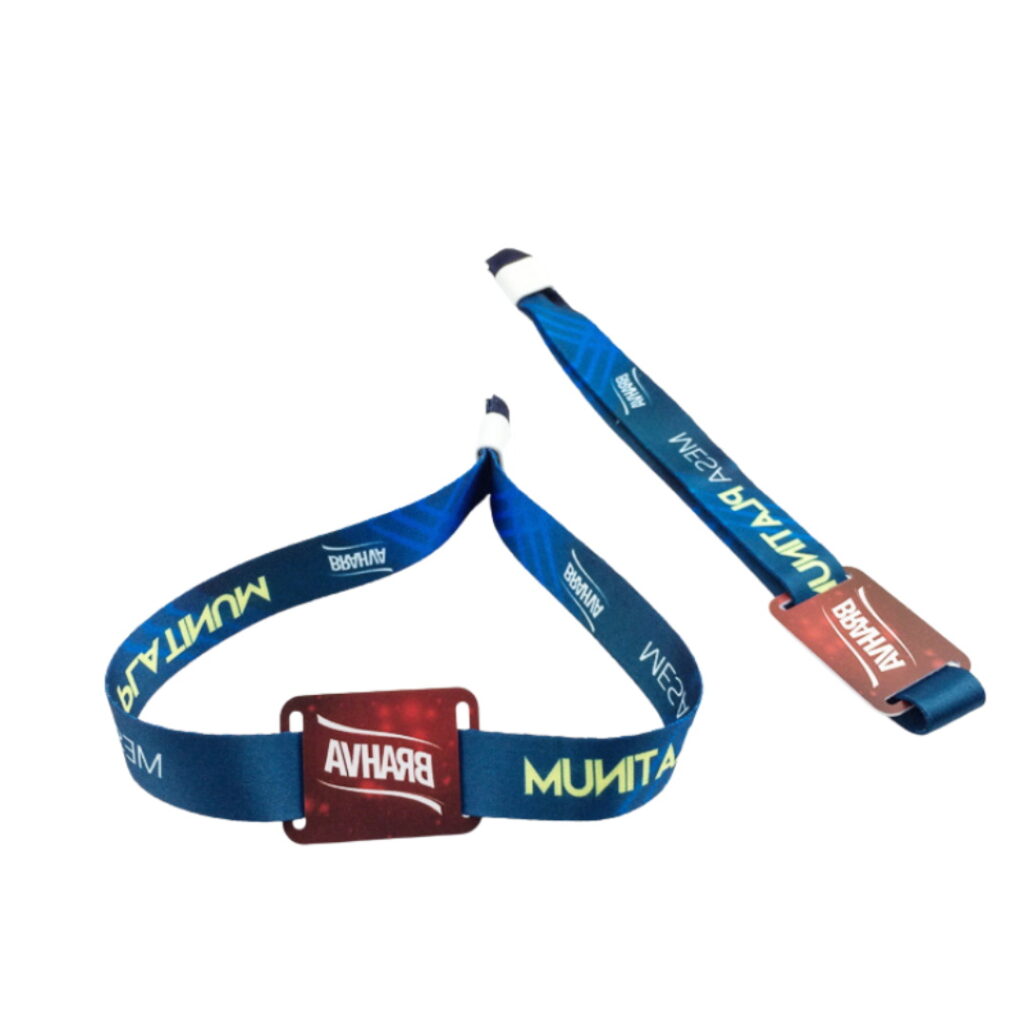
The Growing Importance of RFID Wristbands in the Hotel Industry
Table of Contents
Introduction
This guide explores the technology, benefits, and real-world applications of RFID wristbands in hospitality — including how they improve security, enable cashless payments, and support sustainability initiatives.

What Are RFID Wristbands and How Do They Work?
RFID (Radio Frequency Identification) wristbands are wearable devices embedded with RFID chips. These chips communicate with RFID readers using radio waves to perform tasks such as:
- Room access
- Spa or pool facility entry
- Cashless payments at restaurants or bars
- Attendance tracking at events or conferences
Basic RFID System Components:
- RFID Chip (in wristband): Stores unique guest ID
- RFID Reader: Installed at door locks, payment terminals, etc.
- Antenna: Facilitates communication between the chip and the reader
Types of RFID Wristbands for Hotels
Type of Wristband | Material | Common Applications | Key Features |
Silicone | Water parks, hotels, resorts | Waterproof, durable, comfortable | |
PVC | Exhibitions, events | Lightweight, low-cost | |
Paper, Cloth | Events, short-term use | Cost-effective, customizable |
💡 Looking for hotel-grade wristbands? Explore our RFID wristband solutions.

Top Benefits of RFID Wristbands in Hotels
1. Seamless Guest Access
Guests can unlock hotel room doors, access spa areas, and enter private lounges without keys or cards. Simply tap the RFID wristband — no fumbling, no replacements.
2. Contactless Payments
RFID wristbands allow guests to charge meals, drinks, or services to their room account with a tap. This eliminates the need to carry a wallet or card, especially in areas like the pool, gym, or beach.
3. Enhanced Security
Each RFID wristband is uniquely encrypted, reducing the risk of cloning or unauthorized access. Lost wristbands can be quickly deactivated in the system.
4. Durability and Water Resistance
Silicone wristbands are waterproof and built for long-term use, ideal for guests staying at resorts or water-based facilities.
5. Operational Efficiency
RFID systems automate manual processes like guest check-in, door unlocking, and payment logging — reducing staff workload and improving speed.
RFID Wristbands vs. Traditional Key Cards
Feature | RFID Wristbands | Traditional Key Cards |
Convenience | Contactless operation | Requires manual handling |
Security | Unique encryption, low risk of loss | Prone to loss or damage |
Durability | Waterproof, robust materials | Easily damaged |
Functionality | Multi-use (access, payments, booking) | Limited to access only |
Return on Investment: Why RFID Wristbands Are Worth It
Though the initial cost of RFID wristbands may be higher than plastic cards, the long-term ROI is substantial:
- Reduced labor costs (automated access, check-in/out)
- Increased guest spending (cashless convenience encourages purchases)
- Valuable guest insights (track facility usage, dining habits, and stay patterns)
- Less frequent replacements (durable materials last longer)
- Personalized marketing (use RFID data to send targeted offers)
Hotels have reported up to 20% increases in on-property spending after implementing RFID wristband systems.

Real-World Hotel Applications of RFID Wristbands
Resorts & Waterparks
Guests wear silicone wristbands for pool entry, towel access, or snack bar purchases.
City Hotels & Chains
Streamline check-in and room access without front-desk interaction.
Conference Hotels
Manage session access and meal entitlements at large events.
Theme Parks & Entertainment Complexes
Combine guest access, spending, and loyalty tracking into a single wristband.
RFID Wristbands as a Branding Tool
RFID wristbands can be custom-branded with your hotel’s logo, slogan, or colors — turning them into:
- Guest souvenirs
- Social media-worthy accessories
- Passive marketing tools when worn off-property
Customized wristbands also enhance the perception of exclusivity and professionalism.
Supporting Sustainability With RFID Wristbands
Today’s eco-conscious travelers value green practices. RFID wristbands — especially reusable silicone options — help reduce waste caused by disposable cards or paper tickets.
- Silicone wristbands are reusable and recyclable
- PVC wristbands are long-lasting and less wasteful than keycards
- Lower replacement rate = reduced plastic waste
Promoting RFID as a sustainable solution enhances your hotel’s reputation and brand positioning.
Are RFID wristbands waterproof?
Are RFID wristbands waterproof?
Yes. Silicone RFID wristbands are 100% waterproof and ideal for pools, spas, and outdoor use.
Can guests lose or share their wristbands?
Wristbands are linked to individual guest profiles and can be deactivated instantly if lost.
Can RFID wristbands be used for payments?
Yes. Many hotels integrate RFID wristbands with POS systems for secure, cashless transactions.
Are RFID wristbands more secure than key cards?
Yes. RFID wristbands use encrypted data, making them harder to duplicate than magstripe or chip cards.

Ray Zhou
This article was written by Ray Zhou, an RFID technology expert with more than 10 years of industry experience.
Comments
Hot Products

What Is RFID Waste Management
Imagine a city where every trash bin speaks — not literally — but through a tiny chip that tells the system when it’s full, when it’s emptied, and where it went. That’s what RFID waste management is doing today.

What are Bolt Seals and their Applications? | Complete Guide
In global trade and logistics, bolt seals play a crucial role in ensuring cargo security and compliance. These small but powerful devices are designed to lock shipping containers, trailers, and cargo doors with a tamper-evident mechanism.

What is an RFID Card Protector? Benefits, Use Cases, and Buying Guide
RFID technology (Radio Frequency Identification) is everywhere: in your credit cards, ID badges, transit passes, hotel room keys, and more. It offers speed and convenience, but it also opens the door to a new kind of digital theft called “skimming.” That’s where an RFID card protector comes in.

RFID Wristbands for Events: Bulk Buying Guide for Organizers
RFID wristbands for events are becoming the go-to solution for organizers who need faster entry, fraud prevention, and cashless payments at concerts, festivals, and sports venues. Unlike paper tickets or QR codes, these smart wristbands use embedded chips to streamline access, secure transactions, and improve the guest experience.

How RFID Tag on Windscreen Improves Vehicle Access Control and Toll Systems
In today’s fast-paced world, vehicle identification needs to be quick, secure, and contactless. An RFID Tag on the Windscreen provides exactly that — a reliable way to manage toll collection, parking, and gated access without stopping vehicles.

The Benefits of RFID Linen Tags in Commercial Laundry
Managing laundry in hospitals, hotels, or large laundry services is a big job. Each day, thousands of sheets, towels, and uniforms are washed, sorted, and sent back out. But problems like lost linens, sorting mistakes, and manual counting can cost companies a lot of money. For example, mid-sized hotels can lose over $200,000 each year from missing linens.
That’s where RFID Linen Tags come in.
Tags
RELATED BLOGS

What Is RFID Waste Management
Imagine a city where every trash bin speaks — not literally — but through a tiny chip that tells the system when it’s full, when it’s emptied, and where it went. That’s what RFID waste management is doing today.

What are Bolt Seals and their Applications? | Complete Guide
In global trade and logistics, bolt seals play a crucial role in ensuring cargo security and compliance. These small but powerful devices are designed to lock shipping containers, trailers, and cargo doors with a tamper-evident mechanism.

What is an RFID Card Protector? Benefits, Use Cases, and Buying Guide
RFID technology (Radio Frequency Identification) is everywhere: in your credit cards, ID badges, transit passes, hotel room keys, and more. It offers speed and convenience, but it also opens the door to a new kind of digital theft called “skimming.” That’s where an RFID card protector comes in.




